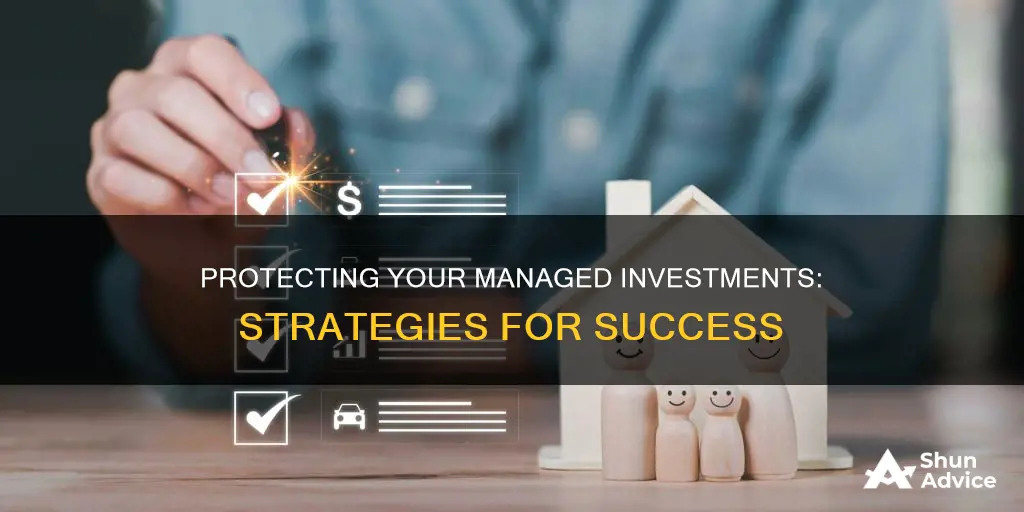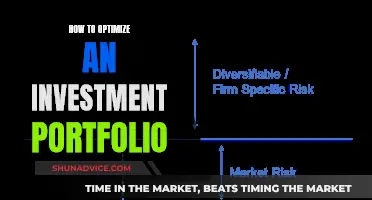
Protecting your investments is a crucial aspect of financial planning, especially in volatile market conditions. Here are some strategies to safeguard your managed investments and build a resilient portfolio:
- Diversification: Spreading your investments across different sectors, asset classes, and geographic locations can reduce the impact of market fluctuations. This strategy ensures that not all your investments are affected by the same market trends, providing a more stable overall performance.
- Non-Correlating Assets: Including assets such as bonds, commodities, currencies, and real estate in your portfolio can help counter systematic risks. These assets often move in the opposite direction of stocks, smoothing out the volatility of your portfolio's overall value.
- Fixed-Income Investments: Instruments like bonds and debt securities provide a steady income stream, reducing overall portfolio risk. They offer consistent returns, shielding your portfolio from unexpected market changes.
- Risk Management: Implementing stop-loss orders can limit potential losses by triggering the sale of stocks at a predetermined price. While this strategy has its supporters and detractors, it can be an effective tool for managing risk during volatile market conditions.
- Portfolio Rebalancing: Regularly reviewing and rebalancing your portfolio ensures it aligns with your risk tolerance and financial goals. This involves selling assets that have increased in value and buying depreciated assets to maintain the desired allocation.
- Investment Research and Due Diligence: Before investing, thoroughly research the investment opportunity and the professionals involved. Understand the fees, risks, and historical performance associated with the investment.
- Long-Term Perspective: Market volatility is a normal part of investing, and a long-term perspective is essential. Avoid making impulsive decisions based on short-term market movements, and focus on your investment strategy and risk tolerance.
By employing these strategies, you can enhance the protection of your managed investments, mitigate potential losses, and work towards achieving your financial objectives.
What You'll Learn

Research your investment and the investment professional
Researching your investment and the investment professional is a critical part of protecting your managed investments. Here are some detailed steps to guide you through this process:
Researching Your Investment:
- Due Diligence: Before investing, conduct thorough research. Understand the company's financial health, business model, management team, and growth prospects.
- Information Sources: Companies are required to disclose certain information to the public. Utilize platforms like EDGAR to access companies' financial reports, regulatory filings, and news updates. This information will help you make informed decisions.
- Diversification: Diversifying your investments across different asset classes, such as stocks, bonds, commodities, currencies, and real estate, is essential. By doing so, you can reduce unsystematic risk and protect your portfolio from the volatility of any single asset class.
- Non-Correlating Assets: Consider adding assets that react differently to market changes. For example, when stocks go down, non-correlating assets like bonds or real estate may provide a hedge, smoothing out the overall volatility of your portfolio.
- Principal-Protected Notes: These are fixed-income securities that guarantee the return of your principal investment if held until maturity. They can be an attractive option for risk-averse investors, but be sure to assess the strength of the guarantor and any associated fees.
Researching the Investment Professional:
- Licensing and Registration: Only work with licensed and registered investment professionals. Check their background, registration status, and disciplinary history through official databases.
- Fees and Costs: Understand the fees associated with the investment products and services. These may include management fees, transaction fees, or miscellaneous charges. Over time, these fees can significantly impact your investment returns.
- Track Record and Reputation: Research the investment professional's track record. Look for a history of successful investments and client satisfaction. Check reviews, testimonials, and any complaints or legal issues associated with the individual or firm.
- Investment Strategy: Ensure that the investment professional's strategy aligns with your goals, risk tolerance, and time horizon. Understand their approach to portfolio construction, asset allocation, and risk management.
- Communication and Transparency: Choose an investment professional who communicates clearly and frequently. They should provide regular updates, explain their investment decisions, and be transparent about any potential conflicts of interest.
Remember, researching your investments and the professionals you work with is an ongoing process. Stay informed about any changes that may impact your investments, and don't hesitate to seek clarification or additional information when needed.
Diversifying Your Portfolio: Strategies for Investment Options
You may want to see also

Know the fees you're paying
When it comes to managed investments, it's crucial to be aware of the fees you're paying to avoid any nasty surprises. Here are some detailed instructions on how to do that:
Firstly, it's important to understand that fees and costs are associated with any investment, just like with any other purchase. While these fees may seem insignificant at first, they can significantly impact your investment portfolio over time. Therefore, it is crucial to review and understand all the fees involved before investing.
Secondly, be sure to inquire about the management fees. Managed accounts often involve hiring a professional money manager or investment advisor, and their services come at a cost. These fees are typically calculated as a set percentage of the assets under management (AUM). For example, money managers may charge six-figure minimum investments, and their compensation is usually around 1% to 2% of the AUM. However, some managers may offer discounts for larger portfolios, so it's worth asking about potential fee reductions.
Thirdly, don't forget about transaction fees. Every time you buy or sell an asset, there may be a fee involved. These fees can vary depending on the type of asset and the number of transactions. Be sure to review the fine print or ask your investment advisor for a breakdown of these fees.
Additionally, some investment advisors or managers may charge performance fees on top of the standard management fees. These performance fees are usually calculated as a percentage of the profits generated by your investments. While this type of fee structure can motivate your advisor to perform better, it's important to understand how these fees are calculated and when they are charged.
Finally, be mindful of any hidden fees or charges. Some investment products may have additional costs associated with them, such as account maintenance fees, transfer fees, or early withdrawal penalties. It is crucial to read the terms and conditions carefully and ask questions to ensure you are aware of all the potential costs involved.
Remember, understanding the fees you're paying is an essential part of managing your investments effectively. Don't be afraid to ask questions and seek clarity from your investment advisor or manager. It's your money, and you have the right to know exactly where it's going.
Building a Solid Investment Portfolio with a $2,000 Foundation
You may want to see also

Beware of investment scams
Investment scams are a serious threat to your financial security. Fraudsters are always looking for new ways to separate you from your money, so it's important to be vigilant and informed. Here are some essential tips to help you avoid falling victim to investment scams:
- Research Your Investment: Always conduct thorough research before investing. Review disclosures, financial reports, and regulatory filings to understand the risks and historical performance. Never invest with someone who is not licensed and registered.
- Know the Red Flags: Learn the common signs of investment scams, such as promises of guaranteed high returns, pressure to act quickly, unsolicited offers, and complex or vague investment strategies.
- Due Diligence on Investment Professionals: When working with an investment professional, carefully review their background, registration status, disciplinary history, and fee structure. Ensure they are licensed and registered.
- Monitor Your Accounts: Regularly review your investment accounts for any suspicious activity or unauthorised changes. Stay alert for any unexpected transactions or modifications to your personal information.
- Be Wary of Unsolicited Offers: Be cautious of unexpected emails, calls, or messages offering investment opportunities. Verify the legitimacy of the sender and never provide personal or financial information without proper authentication.
- Seek Diversification: Diversifying your investments across different asset classes, sectors, and geographies can help reduce the impact of potential scams. Don't put all your eggs in one basket.
- Report Suspected Fraud: If you encounter suspicious investment opportunities or believe you have been a victim of fraud, report it to the relevant authorities, such as the Securities and Exchange Commission (SEC) in the United States.
Remember, if an investment opportunity seems too good to be true, it probably is. Always exercise caution, conduct thorough research, and seek advice from trusted financial professionals to protect yourself from investment scams. Your hard-earned money deserves to be safeguarded!
Demand-Supply Equilibrium: Savings, Investments Balance
You may want to see also

Monitor your accounts
Monitoring your accounts is a crucial step in protecting your managed investments. Here are some detailed instructions and considerations to keep in mind:
Regularly Review Your Account Activity
Review your account statements and transaction confirmations regularly. Look for any suspicious or unauthorised activity. Confirm that all transactions are legitimate and align with your investment objectives. This proactive approach will help you identify any potential issues or discrepancies promptly.
Be Vigilant for Any Unrecognised Changes
Keep a close eye on your account information and details. Be alert for any changes that you did not initiate or authorise. For example, monitor for alterations to your address, phone number, email address, account number, or bank information. Such changes could indicate identity theft or fraudulent activity and should be addressed immediately.
Understand the Importance of Monitoring
Monitoring your accounts is a critical aspect of investment management. It helps protect your financial interests and ensures that your investments align with your goals and risk tolerance. By staying vigilant, you can quickly identify and address any potential issues, minimising the impact of unauthorised or fraudulent activity.
Stay Informed About Market Trends and News
Keep yourself informed about market trends, news, and economic indicators that can impact your investments. Being aware of market volatility, interest rate changes, and economic shifts can help you make more informed decisions and anticipate potential risks or opportunities. This proactive approach will enable you to adjust your investment strategy accordingly.
Utilise Automated Alerts and Notifications
Many investment platforms and financial institutions offer automated alerts and notifications. Set up these alerts to notify you of any significant account changes or activities. For example, you can receive notifications for large transactions, password changes, or login attempts from unfamiliar devices. These alerts provide an additional layer of security and help you stay on top of your account activity.
Seek Professional Guidance if Needed
If you feel overwhelmed or uncertain about monitoring your accounts effectively, consider seeking guidance from a financial advisor or investment professional. They can provide expertise in risk management and portfolio monitoring. These professionals can help you interpret market trends, assess the performance of your investments, and make informed decisions to protect your financial interests.
Remember, monitoring your accounts is an ongoing process that requires diligence and attention to detail. By staying vigilant and proactive, you can better protect your managed investments and quickly address any potential issues or discrepancies.
Liquid Assets: Investment Portfolios for Quick Cash Access
You may want to see also

Choose non-correlating assets
Choosing non-correlating assets is a crucial strategy for investors to protect their managed investments and reduce the risk of potential losses. Non-correlating assets are investments whose price movements are independent of each other. Here are some detailed tips for choosing non-correlating assets:
- Understand Asset Correlation: Recognize the relationship between different types of investments. Positively correlated assets tend to move together, whether gaining or losing value. Negatively correlated assets move in opposite directions, and non-correlated assets have independent price movements.
- Diversify Your Portfolio: Include a mix of negatively correlated and non-correlated assets in your portfolio. This diversification helps to reduce the overall risk and volatility of your investments.
- Consider Precious Metals: Gold, in particular, has traditionally been viewed as a smart non-correlated asset. It often correlates more with a positive market and less with a negative market. Other precious metals can also be good options for diversification.
- Explore Real Estate: The real estate market often performs independently of the stock market. You can invest in individual properties, real estate investment trusts (REITs), or mortgage funds. Real estate investments can provide higher yields, tax advantages, and stable income.
- Evaluate Digital Assets: Cryptocurrencies, non-fungible tokens (NFTs), and other digital assets have their own markets and are not directly linked to the stock market. However, these markets can be highly volatile, so consider your risk tolerance.
- Collect Physical Objects: Artwork, antiques, rare coins, and comic books can add value to your portfolio. Their value may fluctuate over time, and you need to maintain their quality. These assets may also have lower liquidity, so consider the potential challenges in selling them.
- Monitor Correlation Changes: Correlation between assets can change over time. Periodically assess the diversity of your portfolio to ensure that your non-correlated assets remain independent of each other.
- Know Your Risk Tolerance: Some non-correlated assets provide stable returns, while others are more volatile. Understand your comfort level with risk and choose investments that align with your tolerance for volatility.
- Research and Understand Markets: Each type of investment reacts to its own set of influences, such as oil markets, interest rates, or macroeconomic trends. Conduct thorough research to make informed decisions about when to buy and sell various types of assets.
Schwab's Investment Management Services: What You Need to Know
You may want to see also
Frequently asked questions
A managed account is an investment account owned by an investor and managed by a professional money manager. When choosing a provider, it's important to select someone with key qualities such as being proactive, organised, analytical, and having integrity. It's also beneficial to choose someone with situational awareness, investing experience, and knowledge of financial matters.
A managed account can be beneficial as it is a personalised investment portfolio customised to the specific risks, goals, and needs of the account holder. The manager must also act in the best interest of the client or face civil or criminal penalties.
There are several strategies that can be employed to protect your investments, including:
- Diversification: Spread your investments across different sectors, locations, and unrelated investments to reduce the impact of market fluctuations.
- Non-correlating assets: Invest in assets that don't follow the same trends as other asset classes, such as bonds, commodities, and real estate.
- Fixed-income investments: Invest in fixed-income securities such as bonds and debt instruments to provide a stable income stream and lower overall volatility.







